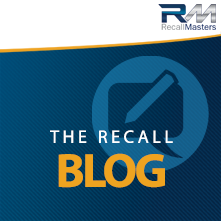Update to CDC Guidelines Causes Auto Dealers to Re-evaluate Vehicle Sanitizing
Update to CDC Guidelines Causes Auto Dealers to Re-evaluate Vehicle Sanitizing
A Blog Post by Sean Reyes, Chief Marketing Officer for Recall Masters
Over the last year, any business that remained open did everything possible to reassure customers their premises were safe and followed the latest CDC COVID guidelines. Social distancing, masks, and disinfecting surfaces for customers have become standard practices and, in some cases, are mandated by states. These measures require extra work and extend vehicle turnover time which, as a consequence, reduces revenue. Still, to build consumer confidence in service at the dealership, most made that investment by adding complimentary vehicle sanitization at drop-off.
A recent article in the NY Post shares newly released CDC guidelines which state that surface-level transmissions are infrequent and pose a relatively low exposure rate to COVID of about 1 in 10,000. According to the article, the most frequent way COVID is contracted is through “direct contact with a sick person or from airborne transmission,” not from surfaces. The updated guidelines come as a bit of an insult to small businesses, dealerships included, that purchased equipment/chemicals or paid staff to wipe down surfaces after every interaction. Let’s not cry over spilled milk. What’s done is done. More importantly, what consumers believed is what we all believed – and to earn their business, we instituted policies that no one questioned at the time.
Many dealerships spend a lot of time (and money) on disinfectants and, ultimately, labor hours to disinfect surfaces. Whether those surfaces are desks in the dealership, service vehicles, or cars on the lot, the CDC now reports that disinfectants currently aren’t necessary, stating, “There is little scientific support for routine disinfectants in community settings whether indoor or outdoor to prevent spread through surfaces.” The CDC also states that “In most situations, cleaning surfaces using soap and detergent, and not disinfecting, is enough to reduce the risk.”
What does this new update mean for dealerships? If this is the “new normal,” does the average consumer still expect their vehicle to be disinfected after service? And at the dealership’s expense?
Many dealers spend a significant amount on disinfectants for vehicles in the service drive when, according to the new CDC guidelines, currently all that is needed is to wipe the vehicles down with soap and water. This can save time, help increase shop capacity, and the volume of vehicles serviced.
Think about how many times disinfectant is used on a vehicle and the expense of that disinfectant. Perhaps a dealership disinfects a service vehicle 4-5 times: When it is checked in, again during the MPI, again before the technician services the vehicle, then again once the vehicle service is completed. That’s a lot of work for something the CDC now states is no longer necessary.
What about sales? Dealerships are disinfecting vehicles after each test drive. And, what about those customers who test drive multiple vehicles? Then they may sit at a salesperson’s desk and, if the dealership closes the deal, customers could be sitting in a waiting area (just like in service.) Is someone following behind every customer disinfecting everything a customer touches?
Of course, customer perception of safety and convenience must be at the top of your importance list and it is key to communicate your safety measures to your customers in a way that makes them feel 100% safe when visiting your dealership.
While the CDC’s update has been widely publicized, it may take a while for the average consumer to learn about it or feel comfortable with the policy. I admit that, if consumers are not current with CDC safety guidelines, it may be a bit of a challenge getting the right message across to your customers, so they do not think you are cutting corners. A good strategy is to post the latest data on your website. Make it highly visible. Get the right message across that the safety of your customers is your #1 priority. Make a video and include it in an email to your customers with their service appointment reminders.
It is certainly a balancing act that needs to be done right. Reassuring customers that sanitary measures are in place in your dealership is an important value proposition. But the latest CDC guidelines about COVID transmission could save you a considerable amount of money and labor hours.
About the Author


